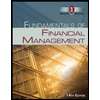
Concept explainers
PROBLEM 13C-3 Income Taxes and
Lander Company has an opportunity to pursue a capital budgeting project with a five-year time horizon. After careful study, Lander estimated the following costs and revenues for the project:
Cost of equipment needed………………………………….. $250,000
Repair the equipment in two years………………………….. $18,000
Annual revenues and costs:
Sales revenues………………………………………………… $350,000
Variable expenses…………………………………………….. $180,000
Fixed out-of-pocket operating costs………………………….. $80,000
The piece of equipment mentioned above has a useful life of five years and zero salvage value. Lander uses straight-line
Required:
- Calculate the annual income tax expense for each of years 1 through 5 that will arise as a result of this investment opportunity.
- Calculate the net present value of this investment opportunity.
Want to see the full answer?
Check out a sample textbook solution
Chapter 14 Solutions
MANAGERIAL ACCT(LL)+CONNECT+PROCTORIO PL
- I am searching for a clear explanation of this financial accounting problem with valid methods.arrow_forwardAllstate Enterprises has a discontinued operation gain of $60,000 and a 30% tax rate. What is the effect on net income? a. Increase of $42,000 b. Increase of $60,000 c. Increase of $18,000 d. No effectarrow_forwardI need help solving this general accounting question with the proper methodology.arrow_forward
- I am searching for the correct answer to this general accounting problem with proper accounting rules.arrow_forwardCan you solve this general accounting question with accurate accounting calculations?arrow_forwardI am searching for the accurate solution to this general accounting problem with the right approach.arrow_forward
- What are the total assets?arrow_forwardPlease provide the correct answer to this financial accounting problem using valid calculations.arrow_forwardParker Enterprises applies manufacturing overhead costs to products at a budgeted indirect-cost rate of $90 per direct manufacturing labor hour. A wholesale distributor has requested a bid on a special order of the Model Train product. Estimates for this order include direct materials of $82,000, 750 direct manufacturing labor hours at $45 per hour, and a 25% markup rate on total manufacturing costs. Manufacturing overhead cost estimates for this special-order total: a) $67,500 b) $58,500 c) $70,000 d) $78,250arrow_forward

 Fundamentals Of Financial Management, Concise Edi...FinanceISBN:9781337902571Author:Eugene F. Brigham, Joel F. HoustonPublisher:Cengage Learning
Fundamentals Of Financial Management, Concise Edi...FinanceISBN:9781337902571Author:Eugene F. Brigham, Joel F. HoustonPublisher:Cengage Learning Fundamentals of Financial Management, Concise Edi...FinanceISBN:9781305635937Author:Eugene F. Brigham, Joel F. HoustonPublisher:Cengage Learning
Fundamentals of Financial Management, Concise Edi...FinanceISBN:9781305635937Author:Eugene F. Brigham, Joel F. HoustonPublisher:Cengage Learning Fundamentals of Financial Management (MindTap Cou...FinanceISBN:9781285867977Author:Eugene F. Brigham, Joel F. HoustonPublisher:Cengage Learning
Fundamentals of Financial Management (MindTap Cou...FinanceISBN:9781285867977Author:Eugene F. Brigham, Joel F. HoustonPublisher:Cengage Learning Fundamentals of Financial Management, Concise Edi...FinanceISBN:9781285065137Author:Eugene F. Brigham, Joel F. HoustonPublisher:Cengage Learning
Fundamentals of Financial Management, Concise Edi...FinanceISBN:9781285065137Author:Eugene F. Brigham, Joel F. HoustonPublisher:Cengage Learning Intermediate Financial Management (MindTap Course...FinanceISBN:9781337395083Author:Eugene F. Brigham, Phillip R. DavesPublisher:Cengage Learning
Intermediate Financial Management (MindTap Course...FinanceISBN:9781337395083Author:Eugene F. Brigham, Phillip R. DavesPublisher:Cengage Learning





